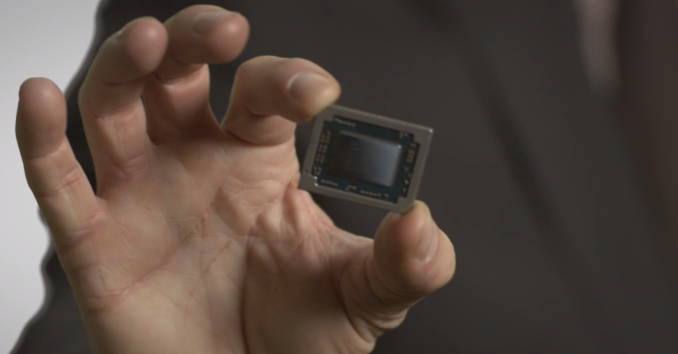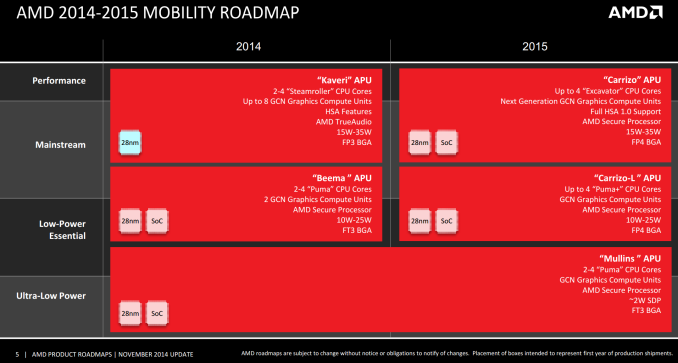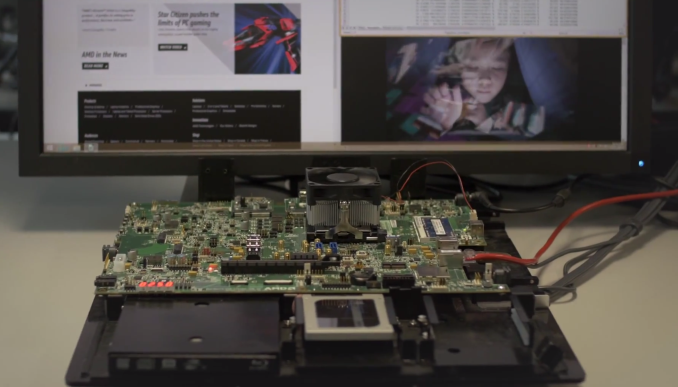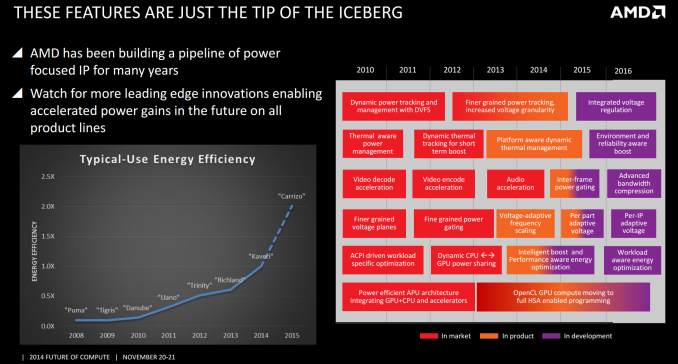AMD’s Carrizo not on the Desktop? Depends What You Define as Desktop
by Ian Cutress on January 13, 2015 5:20 AM EST
We reported on AMD’s next iteration of their Bulldozer architecture, code named Excavator, during the press release regarding their next processor line up called Carrizo. At the time, the focus for Carrizo (and Carrizo-L) was aimed at notebooks and laptops, with the road-map from AMD on 2015 looking at 15-35W BGA parts in the performance and mainstream. Carrizo-L specifically took Puma+ cores, from the Cat family of cores, down to 10-25W, with Mullins running the ultra-low-power market at 2W. All of these being full SoCs, and soldered down BGA packages. The feeling at the time was that Carrizo would be a mobile focused launch, with the potential for desktop to be examined at a later date as AMD takes pride in owning the desktop integrated graphics title with Kaveri, and AMD would need something to compete against the upcoming Broadwell as well as Skylake in 2015.
However, in our periphery we noted The Tech Report come out and categorically state that ‘Carrizo will face off with Broadwell-U, won’t land in desktops’. The first part of that is definitely true, with Carrizo’s 15W-35W range synchronizing nicely with Broadwell-U’s 15W-28W parts, however the second part of it is somewhat new. Up until this point, AMD had neither confirmed nor denied (in true CIA style) about the future of their desktop landscape, to the point that their desktop roadmap stopped at 2014:
The Tech Report mentions a single line to the claim: ‘AMD has no plans to offer Carrizo as a socketed chip for desktop PCs’. We reached out to AMD for some form of confirmation or explanation as to this line, because it felt kind of odd. With a well-positioned launch, with enough SKUs in enough markets to cater up and down the price range, AMD could re-launch the APU line with the latest architecture updates for the better. We received the following response from AMD’s James Prior:
“With regards to your specific question, we expect Carrizo will be seen in BGA form factor desktops designs from our OEM partners. The Carrizo project was focused on thermally constrained form factors, which is where you'll see the big differences in performance and other experiences that consumers value.”
There’s no direct denial of socketed Carrizo based parts here, but all arrows point to BGA desktops, such as all-in-ones and mini-PCs (the high-end segment for Broadwell-U). We have seen at least one socketed part, when AMD launched its Carrizo video:
But this was labelled as a pure engineering sample when we saw it at AMD’s suite at CES. So while we can’t confirm the ‘no plans’ part from TR’s quote, Carrizo as a socketed part for desktops is currently not public knowledge as of yet. AMD is in a quiet period right now and not wanting to rock the boat from what is currently on the market by announcing anything on the desktop side. This is despite AMD’s list of features being a prominent slide in their Carrizo slide deck, most of which would be important parts within a desktop environment.
If AMD is planning no further socketed desktop APUs from the base-Bulldozer architecture, we would have to head towards Jim Keller's team and K12/Zen in 2016 as the next port of call, despite that platform currently being touted more for low power, servers and embedded right now. Part of me wants to believe we won’t have to wait that long, given that Kaveri first appeared in January 2014 at it would mark a two-to-three year gap on the desktop side. Even AMD would have a hard time explaining that one, unless it made financial sense overall.














34 Comments
View All Comments
silverblue - Tuesday, January 13, 2015 - link
TDP != general power consumption.SaberKOG91 - Tuesday, January 13, 2015 - link
Not really that much of a stretch. The Athlon 5350 has a 25W TDP. Sure that won't go into a tablet, but it's definitely low enough for NUC or an AIO. With a top TDP of 35W, Carrizo easily fits into modern thermal envelopes. Carrizo-L is plenty low enough for tablets, even if Mullins didn't score any major design wins.beginner99 - Wednesday, January 14, 2015 - link
> "AMD is all about the whole user experience. Most consumers (non-gamers) don't need very much in the way of CPU power. A 2+ GHz dual or quad will meet the majority need. This, paired with AMD's professional grade graphics, is meant to allow for a fluid user experience. "I see it exactly the other way. Even crappy Baytrail Celeron graphics is good enough for most consumers. In fact the only reason for needing 3D in the consumer space is gaming. So if I configure a PC for such users I rather invest the money in SSD, CPU and last GPU. Here AMD will always loose as you pay a ridiculous fee for the iGPU no office user really needs. Any ofice user is better served with a pentium due do faster single threaded performance (and less power).
otherwise - Thursday, January 15, 2015 - link
You need to take a step back from AMD's marketing and ask yourself if the proposed scenario makes any sense. For example, the SolidWorks use case. If you're not a student this software is $4K a seat plus $1.5K a year maintenance. What company would spend that kind of money, then decide to cripple its abilities by pairing it with a $300 system?lefty2 - Tuesday, January 13, 2015 - link
Except that Carrizo's iGPU could well trash Broadwell's iGPU. Especially if the Iris Pro availablity is the same as is was for Haswell (i.e. nearly non-existant)Salvor - Tuesday, January 13, 2015 - link
But then you're back to the same old APU problem, people who actually need that extra graphics power will/should be buying a discrete GPU anyway, and those who don't can generally get by fine on intel's offerings.Kevin G - Tuesday, January 13, 2015 - link
The catch is that most OEMs don't want to spend the extra money for an additional chip. Even if they were free, OEMs designs have become increasingly power focused where they wouldn't want a discrete chip except for the high end. Even if you wanted a discrete GPU, they're increasingly rare.mrdude - Tuesday, January 13, 2015 - link
So those same OEMs are going to accomodate a more complex and bigger PCB that requires costlier high-speed dual-channel RAM in order to actually allow that GPU to do work? This argument makes no sense.We're in an era where the average laptop chip is a ~15W with a single stick of RAM, if you're that lucky, and it's at low voltage and speed. And even if an OEM was able to somehow make that happen, the GPU side of the chip is still bandwidth limited and performs as such. The constant delays, small and big core both, have left a nasty taste in OEMs' mouths, too.
Carrizo might fix some of these problems, but it's years too late. AMD's APU sales are decreasing and Intel might even leapfrog them in terms of iGPU performance.
lefty2 - Tuesday, January 13, 2015 - link
Buy a descrete GPU for a laptop?dragonsqrrl - Tuesday, January 13, 2015 - link
Iris Pro will be available on desktop for Broadwell. It's funny you should mention that because I find that people often forget or are unaware that Iris Pro even exists. This may no longer be true but when it launched, and for a long while after, Iris Pro was the most powerful igpu on the market. Intel was outperforming AMD's 100W APU's at a 50W TDP. At the time AMD's mobile APU's weren't even close. The thing is I'm not sure much has changed since. The problem was availability and price, and it's looking like this may very well change with broadwell.